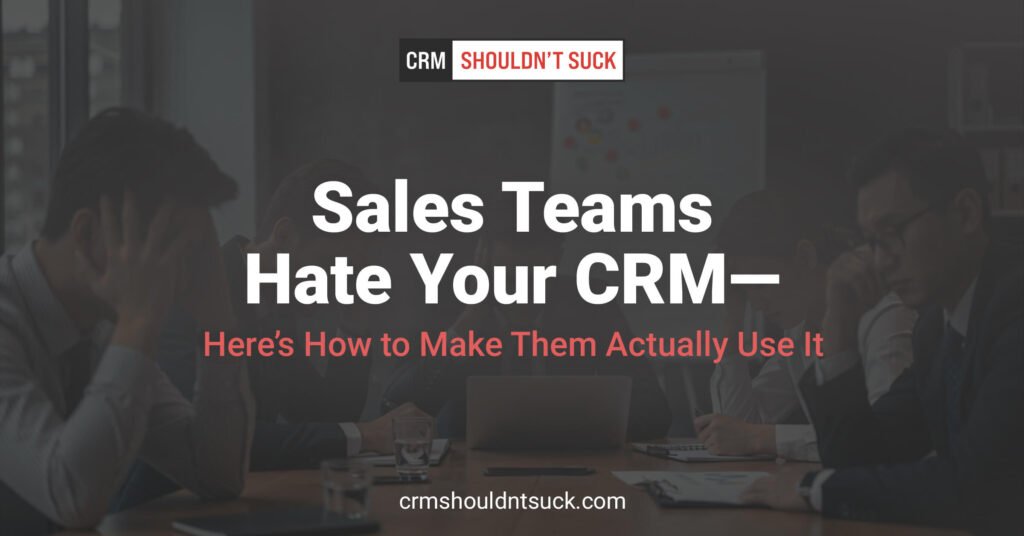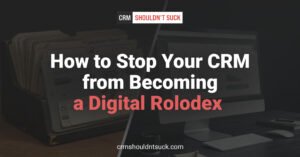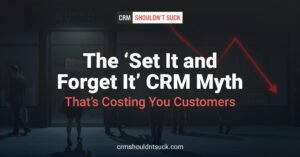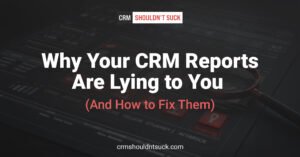The CRM Showdown: Your Sales Team vs. The System
You see the signs everywhere.
Your sales team dodges the CRM like it’s a toxic ex. They grumble about entering data. They find creative ways to track deals—spreadsheets, sticky notes, carrier pigeons—anything but the CRM you spent months selecting and rolling out.
And then comes the worst part: deals start falling through the cracks. Leads disappear into the void. Forecasting turns into wild guessing. Management gets frustrated, and suddenly, instead of boosting sales, your CRM is driving a wedge between leadership and the team.
Sound familiar?
You’re not alone. CRM adoption is one of the biggest struggles in sales organizations. But it doesn’t have to be this way. If your CRM is a source of pain rather than a sales-boosting powerhouse, it’s time to flip the script.
Step 1: Stop Treating CRM as a Corporate Surveillance Tool
The Mistake: Leadership treats the CRM as a way to track reps rather than empower them.
The Reality: Sales reps feel like Big Brother is watching. They see CRM as a tool for micromanagement rather than a way to close more deals.
The Fix: Shift the narrative. Instead of emphasizing compliance, focus on how CRM helps them sell faster, better, and smarter.
Ask yourself:
- Does your CRM make it easier for reps to track deals, or is it just an admin burden?
- Are managers using CRM to help reps succeed, or just to monitor activity logs?
- Are you rewarding CRM usage by tying it to commissions and success stories?
If reps see CRM as a tool for their success—not just a tool for management—they’re far more likely to use it.
Step 2: Kill Data Entry Hell with Automation
The Mistake: Sales reps spend more time logging data than selling.
The Reality: No one wants to spend 30 minutes after every call updating fields. If your CRM demands endless manual updates, reps will avoid it at all costs.
The Fix: Automate everything possible. A great CRM should work for your sales team, not against them.
Look for features like:
- Auto-syncing emails and calls so reps don’t have to log them manually.
- One-click activity tracking instead of multi-step data entry.
- AI-powered reminders and task automation to eliminate busywork.
Less time on admin = more time closing deals. It’s that simple.
Step 3: Integrate It with the Tools They Already Love
The Mistake: Forcing sales reps to live inside a CRM they barely tolerate.
The Reality: If using the CRM feels like stepping into an entirely different universe, they won’t use it. Period.
The Fix: Make the CRM a seamless part of their existing workflow by integrating it with:
- Email and calendar tools like Outlook and Gmail.
- Sales engagement platforms like LinkedIn Sales Navigator.
- Chat apps like Slack or Microsoft Teams.
- Mobile accessibility so they can update deals on the go.
If the CRM fits into their daily routine, adoption skyrockets.
Step 4: Show Them What’s In It for Them
The Mistake: CRM benefits are framed around company-wide efficiency—not individual sales success.
The Reality: Reps don’t care about CRM adoption rates. They care about hitting quota and making money.
The Fix: Show direct, personal benefits of using CRM:
- Faster deal cycles (less back-and-forth, more automation).
- Better commissions (no lost deals due to bad tracking).
- Smarter pipeline management (seeing where they’re likely to win and where to focus efforts).
Make it clear: The reps who use the CRM win more deals and make more money. The rest? They get left behind.
Step 5: Make It a Non-Negotiable (But in the Right Way)
The Mistake: Making CRM use mandatory without providing proper incentives or consequences.
The Reality: If CRM adoption isn’t tied to success, some reps will ignore it forever. If it’s only tied to penalties, resentment builds fast.
The Fix: A balance of incentives and accountability.
- Tied to commissions: No CRM activity? No deal credit.
- Leaderboard gamification: Recognition for those who use it best.
- Coaching and support: Helping reps use CRM better, not punishing them for doing it wrong.
The message should be clear: The CRM isn’t optional. But using it well makes them more successful, not just the company.
The Bottom Line: Your CRM Shouldn’t Be a Sales Rep’s Worst Nightmare
If your CRM isn’t making life easier for your sales team, it’s the wrong CRM—or you’re using it wrong.
Make it about sales enablement, not corporate tracking. Make it about automation, not manual work. Make it about seamless workflows, not extra steps. Make it about winning more deals, not checking management’s boxes.
When you do, your CRM will go from being the most hated part of your sales team’s day… to their most valuable asset.
Ready to make your CRM work for your sales team instead of against them? It starts with choosing a CRM that doesn’t suck.



